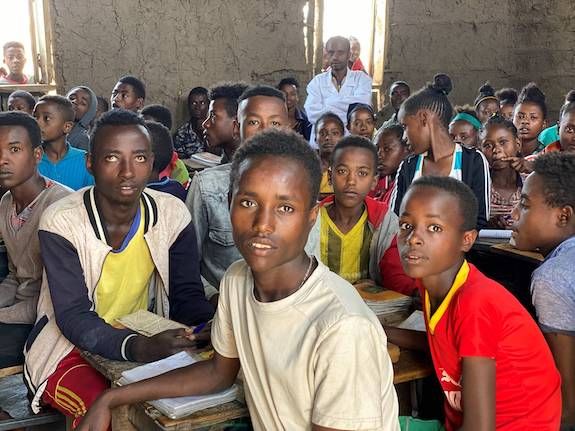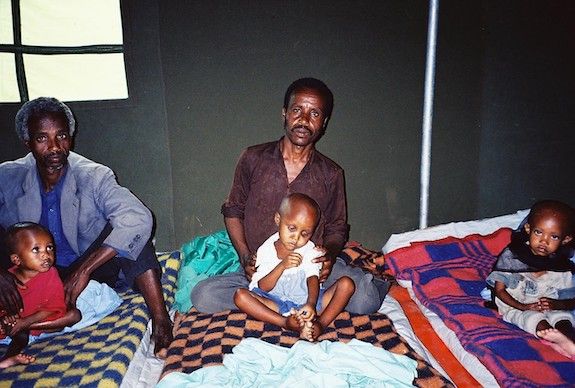Learn more about Hagirso's story and the importance of nutrition through an interactive slideshow here.
Boricha, Ethiopia — The fourth-grade classroom packed with more than 60 students is buzzing with ambition. The teacher has asked an adventurous question: What would they like to be one day?
A girl in the back raises her hand. “I would like to be a nurse, and help people,” she says.
“A doctor,” says a boy leaping to his feet.
“A teacher,” proclaims a voice in the front. “Or a businessman.”
These are universal dreams that float in every fourth-grade classroom in the world. But something is different here in the Shemena Godo Primary School, as revealed by a follow-up question: How old are you?
The answers: 18, 18, 21.
This is a classroom of a stunted generation. About half of the students were small children when famine stalked the country back in 2003. It was the first great hunger crisis of the 21st Century; 14 million people were on the doorstep of starvation. For the children, severe malnutrition in their early formative years resulted in stunted bodies and brains. And stunted ambitions. It is highly unlikely that any of them, just now learning simple math and struggling to read as teenagers and young adults, will achieve their hopes of professional careers helping people.
This is a classroom that also projects a glimpse into the future as another catastrophe spreads, stalking the entire world this time. The Covid-19 health pandemic has swiftly become a food and hunger crisis that threatens millions of children with malnutrition as sure as any famine. Vital school feeding programs have been interrupted. Food supply chains have been severed. Families with lost employment can’t afford food even if it is available. A new generation of malnourished children will carry the impact of the pandemic far into the future, long past the discovery of a vaccine or cure.
Malnutrition and stunting have been a largely hidden, and neglected, disaster. The Global Nutrition Report published last week by an independent group of nutrition, public health and development experts estimated that about 22 percent of all children under five years old in our world today are stunted from malnutrition. That comes to about 149 million children. About 50 million suffer from wasting, or severe underweight, which is more than 7 percent of all children under five. And those awful numbers were compiled before the World Food Program and other United Nations agencies warned that more than 250 million people could face acute hunger if the pandemic sweeps through the developing world as it has through richer countries.
Stunting, which compromises a person’s cognitive development, physical growth and immune system, is a life sentence of underachievement. For stunted children become stunted adults. The cost is paid by all of us, as the impact of stunting ripples from the individual to the family to the community and, finally, to the world as a whole. The Ethiopian government, in a report compiled several years ago when its national stunting rate hovered near 50 percent, estimated the cumulative cost of malnutrition to be about 16 percent of its gross domestic product (GDP) annually. The World Bank calculated that sub-Saharan Africa and South Asia each lose about 11 percent of GDP annually. It put the global cost at about $3.5 trillion a year in lower education, diminished workplace productivity and higher health care expenses. In our global economy, a stunted child anywhere becomes a stunted child everywhere.
But the greatest cost can’t be measured. It is a poem not written, an innovation not nurtured, a horizon not explored, a cure not discovered. What might a person have accomplished were she or he not stunted? A lost chance of greatness for one child is a lost chance for us all.
In this fourth-grade classroom in Ethiopia’s Sidama region, I’m most interested in the progress of one student in particular: Hagirso, the 21-year-old in the first row. I first met him in an emergency feeding tent during the famine of 2003. He was five years old and weighed just 27 pounds. He was receiving therapeutic feeding treatment and slowly beginning to improve. But the doctors and humanitarian workers were worried that he wouldn’t survive, so severe was the malnutrition shock.
Hagirso did survive, as I learned five years later when I returned to the scene of the great hunger. But he clearly wasn’t thriving. He was now 10, but noticeably smaller than even younger children. And he wasn’t in school. “He isn’t able for it,” his father, Tesfaye, a smallholder farmer, told me.
I returned after another five years and this time found Hagirso in school, smiling broadly. At 15, he was in the first grade, beginning to learn the alphabet.
In December 2019, I returned again to Boricha. Hagirso is now a young adult and one of the oldest in his fourth-grade class. In the past six years he had advanced only three grades in school. This is typical of stunted children, who often repeat classes, learn less while in school, and drop out earlier, according to a study in Guatemala that has been measuring the impact of malnutrition on a cohort of children since the 1970s. In the workplace, they earn 20-40 percent less. And they are more susceptible to chronic diseases as adults.
At home, on a small plot of land, Hagirso helps his father raise their crops of maize, potatoes and kale and tend to the family’s cow and calf. He also helps out regularly on community tree-planting and rain-harvesting efforts. He shares the ambitions of his classmates; he says he’d like to be a doctor, “like those who helped me.” Or maybe a teacher or businessman or government clerk – any profession, he says, that would take him away from his little rural village. At the moment, though, he is struggling to master reading, writing and multiplication. At 21.
“I want to keep learning,” he says. “I’ll stay in school as long as I can.”
For decades, nutrition was sorely neglected in international development, receiving less than 1 percent of all international aid spending. In recent years, though, as data on the costs of childhood malnutrition accumulated, nutrition has moved higher up the global agenda. In 2016, the United Nations declared a Decade of Nutrition to push for greater investment. Maternal and child nutrition programs proliferated, particularly ones targeting the first 1,000 days from conception through the second birthday.
Ethiopia, in particular, prioritized improving nutrition and reducing stunting. And it began posting impressive results, with stunting rates falling from 58 percent in 2000 to 38 percent by 2016. In recent years, progress has plateaued, with the rate now stubbornly at about 37 percent. Global efforts have followed the same trend: total numbers of stunted children have dropped from about 165 million in 2012 to 149 million in 2018, representing a 10 percent relative decrease, as noted in the Global Nutrition Report. But it still isn’t nearly enough to meet the World Health Assembly goal of reducing stunting by 40 percent, to about 100 million children, by 2025. The reduction of child wasting to a global target rate of less than 5 percent is even slower.
As the Covid-19 pandemic threatens further setbacks, emerging nutrition efforts are focusing on accelerating successful community-based programs, especially those that aim to prevent bursts of acute malnutrition from spiraling into more severe cases that result in wasting and stunting. The Eleanor Crook Foundation, for example, is partnering with non-governmental organizations and universities in several East African countries, including Ethiopia, to spur research and innovative grassroots nutrition programs that can be scaled up across many communities. The Power of Nutrition movement is rallying governments, the private sector and international institutions to ramp up their investments in integrating essential nutrition services at local health care facilities. In Ethiopia, it is aiming to bring micronutrient supplementation and the promotion of good nutrition behaviors to nearly 20 million children and mothers by the end of next year.
In December, after visiting Hagirso, I returned to the site of the emergency feeding tents where I had first met him. A hospital now stands where the tents once did. Instead of parents arriving with dying children in their arms hoping they can somehow be saved, they now arrive with healthy children and hopes to keep them that way. In the hospital courtyard, the World Food Program, which in 2003 led the emergency feeding efforts, was now leading a nutrition education workshop for new moms and moms-to-be.
Several dozen women sat on the grass, under broad shade trees. They were children themselves during the 2003 famine. Now, they participated in a cooking class featuring common foods packed with nutrients. They lined up with their babies, waiting for a nurse to wrap a measuring tape around their upper arm in a screening intended to catch the beginning stages of undernutrition. They pledged to return every month for more lessons and more measurements to make sure they don’t fall behind the nutrition curve.
Hagirso’s mother, Fikre, told me she has attended similar classes, hoping to avoid malnutrition for the four children she had after Hagirso. The oldest of them, a daughter, is named ThankYou, a prayer to God for sparing her from starvation. The youngest, a four-year-old boy, is named Enough, a plea to God that he be their last child, and their last worry about malnutrition and stunting.

